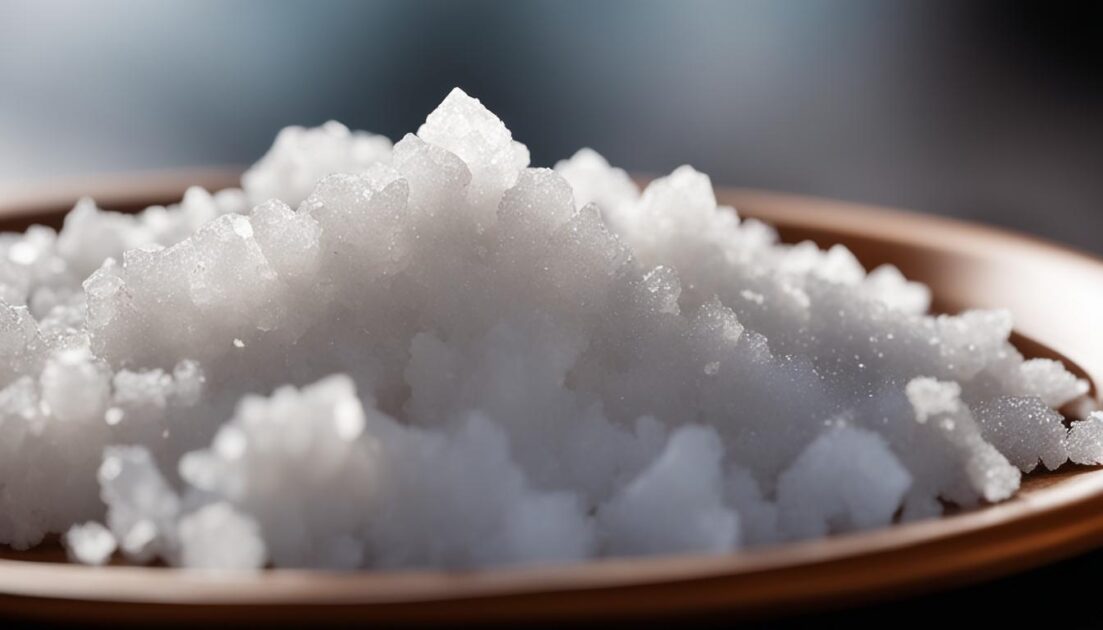Sea salt, a versatile mineral that has been used by people around the world for centuries, offers a range of uses and potential benefits. While primarily composed of sodium chloride, sea salt also contains trace minerals such as potassium, iron, and calcium. Although the notion that sea salt is healthier than other salt varieties lacks substantial scientific evidence, it continues to be popular among many individuals. In this article, I will delve into the various uses and potential benefits of sea salt, exploring its downsides as well.
Key Takeaways:
- Sea salt, a versatile mineral, has been used by people worldwide for centuries.
- It is primarily composed of sodium chloride and contains trace minerals.
- Claims about the superior health benefits of sea salt remain inconclusive.
- Despite its popularity, sea salt should be consumed in moderation.
- Further research is required to establish definitive health benefits.
Sea Salt vs. Table Salt
When it comes to choosing between sea salt and table salt, there are a few key differences to consider. While both types of salt serve the purpose of enhancing the flavor of our food, they vary in terms of their nutritional content and processing methods.
Sea salt is known for being minimally processed and retaining its trace minerals, such as potassium, iron, and calcium. These minerals give sea salt its characteristic flavor and color. On the other hand, table salt undergoes heavy grinding and refining, resulting in the removal of most of its natural minerals.
However, it is important to note that the trace minerals in sea salt are present in such small amounts that one would need to consume a large quantity of sea salt to obtain significant nutritional benefits equivalent to those found in whole foods.
One noticeable difference between sea salt and table salt is the size of the granules. Sea salt typically has larger granules compared to the fine texture of table salt. This can affect the way the salts dissolve and distribute throughout the dish.
Now, you might be wondering about the sodium content. While it is true that sea salt contains slightly less sodium per teaspoon compared to table salt due to its larger granules, both types of salt contribute to our daily sodium intake. Excessive sodium intake can increase the risk of high blood pressure and heart disease, irrespective of whether it comes from sea salt or table salt. Therefore, it’s essential to consume both types of salt in moderation.
“Sea salt is minimally processed, retaining its trace minerals, while table salt is heavily ground and has most of its natural minerals removed.”
Nutritional Comparison: Sea Salt vs. Table Salt
Let’s take a closer look at the nutritional differences between sea salt and table salt:
| Nutrient | Sea Salt (1 tsp) | Table Salt (1 tsp) |
|---|---|---|
| Sodium | 1,700 mg | 2,300 mg |
| Potassium | 40 mg | 0 mg |
| Calcium | 10 mg | 0 mg |
As shown in the table above, sea salt contains slightly less sodium but also provides small amounts of potassium and calcium compared to table salt.
Overall, while sea salt may offer trace minerals and have a coarser texture, it’s important to remember that both sea salt and table salt should be used in moderation to maintain a healthy sodium intake.
Possible Benefits of Sea Salt
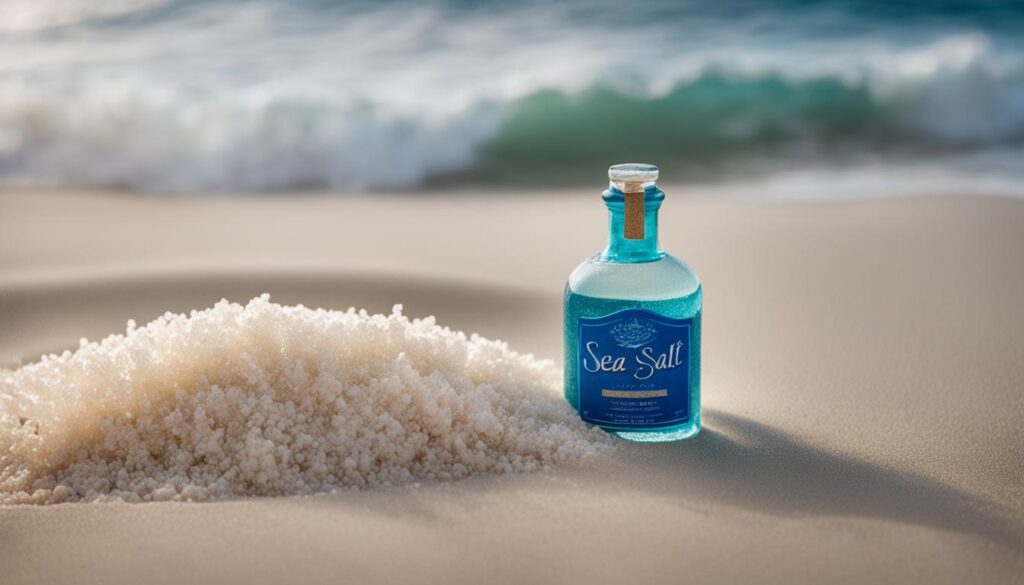
Sea salt offers a range of potential benefits, making it a valuable addition to your daily routine. Let’s explore some of the advantages associated with this versatile mineral.
Improved Hydration and Fluid Balance
Sea salt can help maintain optimal hydration and fluid balance in the body. Its sodium content helps regulate the body’s water levels, ensuring that cells receive adequate hydration. Proper hydration is essential for overall health and helps support various bodily functions, including digestion and circulation.
Healthy Blood Pressure Levels
Maintaining healthy blood pressure is vital for cardiovascular health. Sea salt contains sodium, which plays a role in regulating blood pressure levels. Proper consumption of sea salt, along with a balanced diet and a healthy lifestyle, can contribute to maintaining optimal blood pressure.
Aid in Digestion
Sea salt can aid in digestion by promoting the production of stomach acid. Adequate stomach acid is essential for breaking down food and absorbing nutrients effectively. Adding a pinch of sea salt to meals can help support the digestive process and enhance nutrient absorption.
Enhanced Skin Health
Sea salt has long been used in skincare products and as a natural remedy for skin conditions. Its properties can help alleviate dryness, inflammation, and irritation. Sea salt is often used in baths and scrubs to exfoliate dead skin cells, increase circulation, and provide essential minerals to the skin. This natural ingredient can leave your skin feeling refreshed, moisturized, and rejuvenated.
Remember to incorporate sea salt into your routine in moderation and consult with a healthcare professional if you have specific health concerns.
Possible Downsides of Too Much Salt

Consuming sea salt in moderation is crucial to avoid the downsides associated with excessive sodium intake. Whether it’s sea salt or any other type of salt, consuming too much can lead to various health risks. Excessive sodium intake has been linked to high blood pressure, osteoporosis, kidney stones, and other health issues.
While sea salt may offer some non-dietary benefits and contain trace minerals, it should not be considered a health remedy. It’s important to understand that the beneficial effects of sea salt are primarily derived from its sodium content, which should be consumed in moderation to maintain a healthy balance.
Individuals with kidney disease, high blood pressure, and heart failure should be particularly cautious about their intake of sea salt and other salts. It is advisable for them to consult with healthcare professionals to determine appropriate levels of sodium intake.
The Health Risks of Excessive Sodium Intake
Excessive sodium intake can have detrimental effects on the body. Here are some of the health risks associated with consuming too much salt:
- High blood pressure: Consuming too much salt can increase blood pressure levels, putting strain on the cardiovascular system and increasing the risk of heart disease and stroke.
- Osteoporosis: A diet high in sodium can lead to increased calcium excretion in the urine, potentially contributing to reduced bone density and osteoporosis.
- Kidney stones: Excessive sodium consumption can increase the risk of kidney stone formation by promoting the excretion of calcium in the urine.
- Fluid retention: Consuming excessive amounts of salt can cause the body to retain water, leading to bloating and swelling.
- Increased thirst: High sodium intake can trigger thirst, leading to increased fluid consumption, which may further exacerbate fluid retention.
“While sea salt may have some non-dietary uses and trace minerals, it should not be considered a health remedy. It’s important to understand that the beneficial effects of sea salt are primarily derived from its sodium content, which should be consumed in moderation to maintain a healthy balance.”
It is essential to be mindful of your salt intake and ensure that it aligns with the recommended daily limits. By incorporating a balanced diet and consulting with healthcare professionals when needed, you can make informed choices regarding your sodium consumption and prioritize your overall well-being.
How to Use Sea Salt

Sea salt is a versatile ingredient that can be used in multiple ways, both in cooking and personal care. Whether you’re looking to add flavor to your dishes or enhance your self-care routine, sea salt can be a valuable addition.
Using Sea Salt in Cooking
Sea salt can be used as a substitute for regular salt in most recipes. Its natural flavors and coarser texture can bring out the best in your dishes. However, when replacing table salt in baking recipes, it’s essential to use finely ground sea salt to ensure even distribution.
Here are some ways you can use sea salt in your cooking:
- Sprinkle it on roasted vegetables to add a burst of flavor.
- Add a pinch to desserts like chocolate chip cookies or caramel sauce to enhance the sweetness.
- Use it to season meats and fish before grilling or searing to bring out the natural flavors.
With sea salt, you can elevate the taste of your favorite dishes and explore new flavors in your culinary endeavors.
Sea Salt Baths for Relaxation
A sea salt bath can be a luxurious and rejuvenating experience. The minerals found in sea salt can help promote relaxation and provide potential benefits for the body and mind.
Adding sea salt to your bathwater can:
- Relieve muscle soreness and tension.
- Alleviate skin irritations and inflammation.
- Detoxify the skin and improve circulation.
To create a sea salt bath, simply add a handful of sea salt to your warm bathwater and soak for 15-20 minutes. Feel the stress melt away as the therapeutic properties of sea salt work their magic.
Selecting and Storing Sea Salt
When choosing sea salt, opt for high-quality varieties that are minimally processed and retain their rich mineral profile. Look for brands that prioritize transparency in their sourcing and production methods.
To preserve the flavor and nutritional properties of your sea salt, store it in a cool, dry place away from moisture and humidity. A sealed container or a salt cellar with a lid can help maintain its freshness.
Table: Sea Salt Selection and Storage Tips
| Selection | Storage |
|---|---|
| Choose high-quality, minimally processed sea salt. | Store in a cool, dry place away from moisture. |
| Look for brands that prioritize transparency. | Use a sealed container or salt cellar with a lid. |
By following these tips, you can ensure that your sea salt retains its freshness and flavor, allowing you to enjoy its benefits in your everyday life.
Sea Salt for Skin and Hair

Sea salt has long been recognized for its potential benefits in natural beauty care, offering advantages for both skin and hair. Its unique properties make it a popular ingredient in various skincare products and treatments.
When used as a scrub or in a bath, sea salt can help exfoliate the skin, removing dead cells and revealing a smoother complexion. It stimulates circulation, promoting a healthy glow and restoring vitality to the skin. Additionally, sea salt is rich in essential minerals that can nourish and replenish the skin, supporting its overall health and well-being.
For individuals with dry skin or skin conditions such as eczema, sea salt baths and scrubs can be particularly beneficial. The minerals in sea salt are believed to alleviate dryness, reduce inflammation, and soothe irritations, providing relief and comfort.
When it comes to hair care, sea salt can add texture and volume to your locks. By creating a natural “beachy” look, it enhances the appearance of waves and curls, giving the hair a tousled, effortless effect. Sea salt sprays and hair products are popular choices for achieving this desired style.
| Benefits of Sea Salt for Skin and Hair | Method of Use |
|---|---|
| Exfoliates the skin | Sea salt scrub |
| Improves circulation | Sea salt bath |
| Nourishes and replenishes the skin | Skincare products containing sea salt |
| Alleviates dryness and inflammation | Sea salt baths and scrubs |
| Adds texture and volume to hair | Sea salt sprays and hair products |
Although sea salt has shown potential benefits for skin and hair, individual experiences may vary. It is always advisable to perform a patch test before using sea salt on the skin or hair to ensure compatibility and avoid any adverse reactions.
Sea Salt for Bath and Body
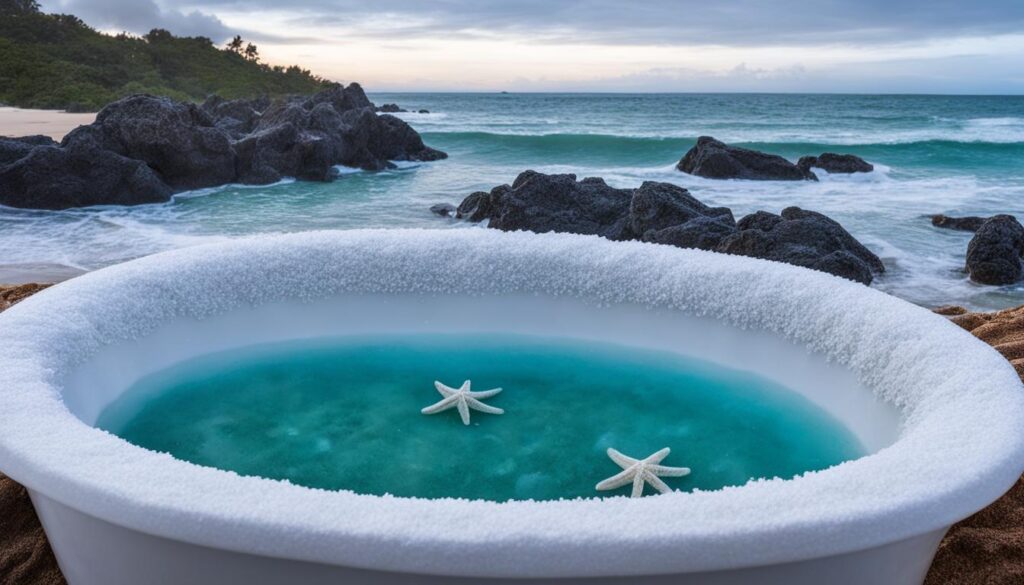
Adding sea salt to your bathwater can provide a relaxing and rejuvenating experience for your body. It is believed that sea salt baths can help promote detoxification, improve circulation, and provide essential nutrients to your skin. The minerals found in sea salt can assist in drawing out toxins and impurities from the skin, leaving you feeling refreshed and revitalized.
One of the potential benefits of sea salt baths is its ability to alleviate muscle soreness and inflammation. The soothing properties of sea salt, combined with warm water, can help ease tension in your muscles and reduce discomfort. Whether you’ve had a long day at work or an intense workout, a sea salt bath can be a wonderful way to relax and soothe your body.
Sea salt baths can also be beneficial for individuals with skin irritations such as eczema or dryness. The minerals in sea salt may help to soothe and hydrate the skin, providing relief from itchiness and inflammation. However, it is important to be cautious and avoid using excessive amounts of sea salt, as it can lead to dryness and may not be suitable for everyone. If you have any skin conditions or specific concerns, it is recommended to consult with a healthcare professional before incorporating sea salt baths into your routine.
To further enhance your bath experience, you can add essential oils or herbs to your sea salt bath. Lavender, chamomile, and eucalyptus are popular choices for their calming and therapeutic effects. Simply mix a few drops of essential oil or a handful of dried herbs with your sea salt before adding it to your bathwater.
| Sea Salt | Table Salt |
|---|---|
| Minimally processed | Heavily ground and refined |
| Contains trace minerals | Most minerals removed |
| Slightly less sodium per teaspoon | Higher sodium content |
Whether you’re looking to relax, detoxify, or simply pamper yourself, incorporating sea salt into your bath and body routine can provide numerous benefits for your overall well-being. Just remember to use it in moderation and consider any individual health concerns you may have. So go ahead, indulge in a sea salt bath and let the benefits wash over you.
Sea Salt for Cleaning
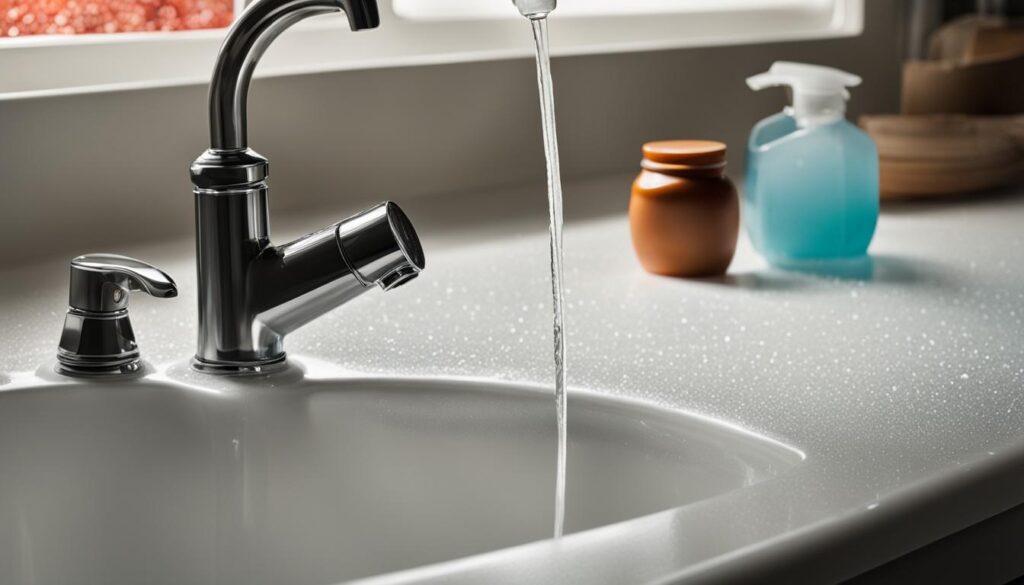
Sea salt is not only beneficial in the kitchen and for personal care but can also be used as a natural cleaning agent. Its coarse texture makes it highly effective for scrubbing surfaces and removing stubborn stains. By mixing sea salt with other natural ingredients such as vinegar or lemon juice, you can create homemade cleaning solutions that are both effective and environmentally friendly.
Homemade Cleaning Solutions
One of the advantages of using sea salt for cleaning is its versatility. Whether you need to clean kitchen countertops, sinks, or bathroom fixtures, sea salt can be your go-to solution. Here are a few examples of how you can use sea salt for different cleaning tasks:
- Clean and deodorize your cutting boards: Sprinkle some sea salt on a damp sponge and scrub your cutting boards to remove stains and eliminate odors.
- Scrub away stains from pots and pans: Create a paste by mixing sea salt with a small amount of water. Apply the paste to the stained areas and scrub gently to remove tough stains.
- Freshen up your coffee mugs: If your coffee mugs have stubborn coffee stains, sprinkle some sea salt inside and scrub with a sponge. Rinse thoroughly and enjoy your fresh, clean mugs.
Testing and Precautions
Before you start using sea salt for cleaning larger surfaces, it is essential to test the cleaning solution on a small, inconspicuous area. This will help you determine if the solution is suitable for the material and to avoid any potential damage or discoloration.
Additionally, it’s important to keep in mind that while sea salt is a natural cleaning solution, it may not be suitable for all surfaces. Avoid using sea salt on delicate materials or surfaces that may scratch easily.
Sea salt can be an effective and eco-friendly alternative to conventional cleaning products. By harnessing the scrubbing power of sea salt, you can achieve sparkling clean surfaces without exposing yourself or the environment to harsh chemicals. Give it a try and experience the natural cleaning capabilities of sea salt!
Sea Salt for Health
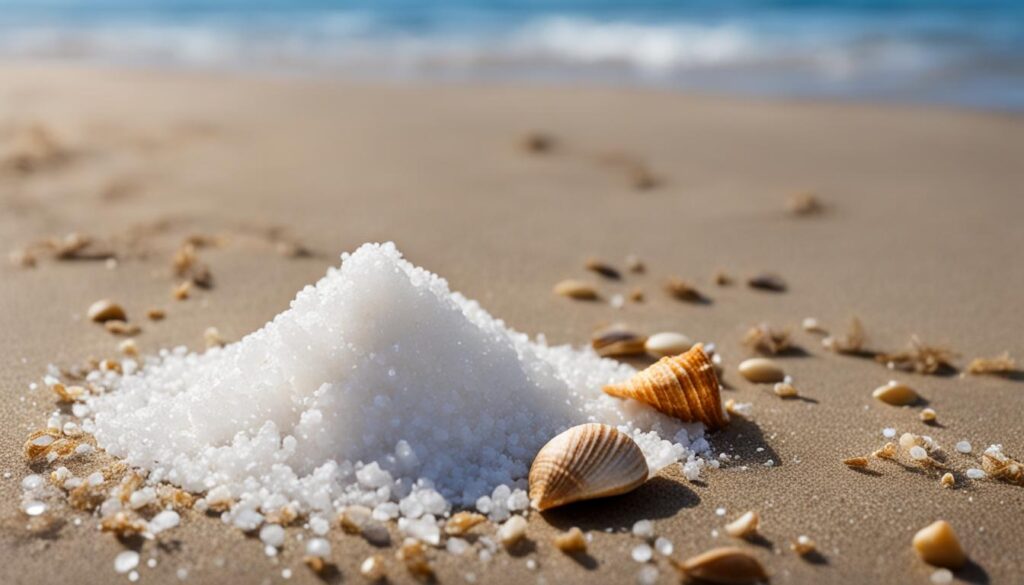
While sea salt can provide some minerals and potential health benefits, it is important to remember that it should be consumed in moderation. Sodium is necessary for optimal health, but excessive intake can lead to health issues such as high blood pressure. Sea salt can be a part of a balanced diet, but it should not be relied upon as a sole source of nutrition. It is important to maintain a varied and nutrient-rich diet and consult with a healthcare professional if you have specific health concerns.
Potential Health Benefits of Sea Salt:
- Promotes Hydration: Sea salt can aid in maintaining adequate hydration and fluid balance due to its sodium content.
- Supports Digestion: Sea salt may aid in digestion by promoting the production of stomach acid.
- Enhances Skin Health: Sea salt has been used in skin care products and baths to help alleviate dryness, inflammation, and irritation.
- Reduces Inflammation: Some studies suggest that sea salt may have anti-inflammatory properties, although more research is needed.
Remember, moderation is key when it comes to consuming sea salt. Excessive sodium intake can have negative effects on health, so it’s important to be mindful of your overall sodium intake and choose high-quality sea salt options.
For a more detailed overview of the potential health benefits of sea salt, see the table below:
| Health Benefit | Description |
|---|---|
| Hydration | Sea salt can aid in maintaining adequate hydration by balancing fluid levels in the body. |
| Digestion | The sodium in sea salt may stimulate the production of stomach acid, aiding in digestion. |
| Skin Health | Sea salt has been used in skincare to help alleviate dryness, inflammation, and skin irritations. |
| Inflammation | While limited studies suggest potential anti-inflammatory properties, further research is needed. |
How to Choose and Store Sea Salt
When it comes to selecting sea salt, opting for high-quality varieties is essential. Look for brands that prioritize transparency in their sourcing and production methods, as this ensures a superior product. High-quality sea salt is minimally processed and retains a rich mineral profile, providing you with the best flavor and nutritional benefits.
Proper storage of sea salt is also crucial to maintain its freshness and quality. To prevent moisture absorption and clumping, store your sea salt in a cool, dry place away from direct sunlight. Consider using a sealed container or a salt cellar with a lid to preserve the flavor and protect it from environmental factors.
Remember to choose sea salt that suits your culinary preferences and dietary needs. Whether you prefer a fine or coarse texture, there are various options available to meet your requirements. Experiment with different varieties to find the one that enhances the flavors of your dishes.
By selecting and storing sea salt correctly, you can ensure that it remains a flavorful and versatile ingredient in your kitchen.
Conclusion
Sea salt is a versatile ingredient with numerous uses and potential benefits. Whether it’s enhancing the flavors in your favorite recipes, rejuvenating your skin and hair, or even aiding in cleaning tasks, sea salt can be a valuable addition to your daily routine.
While sea salt does contain trace minerals and may offer some advantages over highly processed table salt, it’s important to remember that it should be consumed in moderation, just like any other type of salt. Excessive sodium intake can lead to health issues such as high blood pressure, so maintaining a balanced diet is crucial. If you have specific health concerns, consulting with a healthcare professional is recommended.
When choosing sea salt, opt for high-quality varieties that are minimally processed and contain a rich mineral profile. Proper storage in a cool, dry place will help preserve its flavor and nutritional properties. By incorporating sea salt into your lifestyle responsibly, you can enjoy its uses and benefits while maintaining a healthy balance.
FAQ
What is sea salt?
Sea salt is a mineral that is primarily composed of sodium chloride, but it also contains trace minerals such as potassium, iron, and calcium. It is harvested from seawater through evaporation.
How is sea salt different from table salt?
Sea salt is minimally processed and contains trace minerals, while table salt is heavily ground and has most of its nutrients removed. Sea salt also has larger granules, resulting in slightly less sodium per teaspoon compared to table salt.
What are the potential benefits of sea salt?
Some potential benefits of sea salt include improved hydration and fluid balance, maintenance of healthy blood pressure levels, aid in digestion, and enhanced skin health.
Are there any downsides to consuming too much salt?
Yes, excessive sodium intake can lead to health issues such as high blood pressure, osteoporosis, kidney stones, and other health issues.
How can sea salt be used?
Sea salt can be used in cooking as a substitute for regular salt, added to bathwater for a salt bath experience, and used in natural beauty care and cleaning solutions.
Is sea salt beneficial for the skin and hair?
Sea salt has been used in skin care products and baths to help alleviate dryness, inflammation, and skin irritations. When used on the hair, sea salt can add texture and volume.
How can sea salt be used for bath and body?
Adding sea salt to bathwater can help with relaxation, detoxification, improved circulation, and various potential benefits. It can be particularly beneficial for muscle soreness, inflammation, and skin irritations.
Can sea salt be used for cleaning?
Yes, sea salt’s coarse texture makes it effective for scrubbing surfaces and removing stains. It can be used with other natural ingredients to create homemade cleaning solutions for various household tasks.
Is sea salt a healthy choice for consumption?
Sea salt can be part of a balanced diet when consumed in moderation, but it should not be relied upon as a sole source of nutrition. Excessive sodium intake can have health risks, and it is important to maintain a varied and nutrient-rich diet.
How should sea salt be chosen and stored?
When selecting sea salt, it is best to choose high-quality varieties that are minimally processed and contain a rich mineral profile. It is also important to store sea salt in a cool, dry place to preserve its flavor and nutritional properties.
What should I consider before incorporating sea salt into my routine?
It is recommended to consult with a healthcare professional if you have specific health concerns, such as kidney disease, high blood pressure, or heart failure. They can provide personalized guidance on your sea salt intake.
